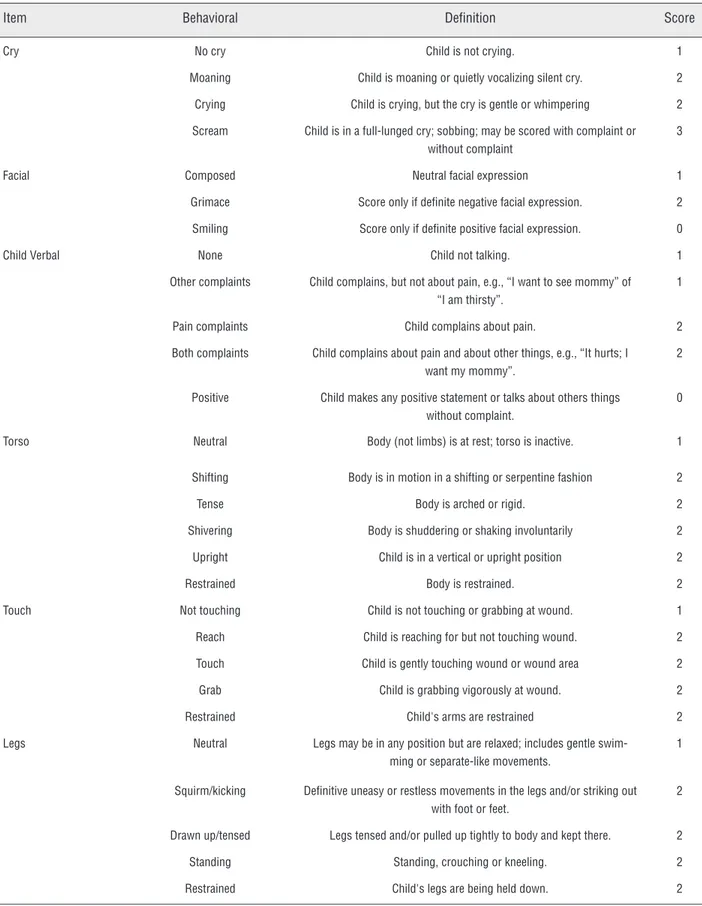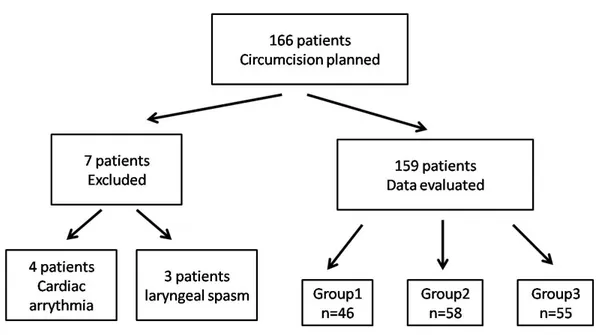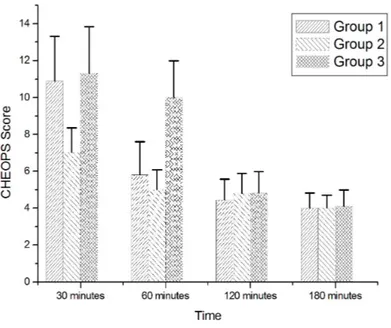Key words:
Circumcision, Male; Analgesia; Penis
Int Braz J Urol. 2013; 39: 551-7 __________________ Submitted for publication: January 25, 2013
__________________
Accepted after revision: June 12, 2013
Purpose: To evaluate the postoperative analgesic efficacy of penile block, caudal block and intravenous paracetamol administration following circumcision.
Materials and Methods: In this prospective randomized study a total of 159 patients underwent circumcision under general anesthesia at urology clinic of Ufuk University Fa-culty of Medicine and Sorgun State Hospital between May 2012 and September 2012. The patients were randomized to three groups to receive penile block (Group 1), caudal block (Group 2) and intravenous paracetamol administration (group 3). Pain measurement of the patients was done via CHEOPS scoring system at 30,60,120 and 180 minutes posto-peratively and compared. Statistical tests were performed with a conventional statistics program and statistical significance was set at a p value of < 0.05.
Results: The mean age of the patients was 5.7 years. Patients in group 1 had significantly lower pain score at 30 minutes compared to other two groups. At 60 minutes groups 1 and 2 had significantly lower score compared to group 3. At 120 and 180 minutes no difference between the groups was observed. No significant major complications were observed in all 3 groups.
Conclusion: Penile block and caudal block provide similar pain scores and painless pos-toperative periods after circumcision under general anesthesia. Intravenous paracetamol is insufficient at the early postoperative period. The three procedures were shown to be safe for analgesia following circumcision.
INTRODUCTION
Penile surgery constitutes an important portion of pediatric urological surgery. Postope-rative analgesia is an important issue especially in the pediatric population. Successfull pain re-lief decreases morbidity, and mobilization in the
early postoperative period decreases the need for narcotic analgesics (1).
Penile block, caudal block, penile ring infiltration, topical local anesthetic application and administration of paracetamol are commonly employed for pain relief after penile surgery (2). Regional techniques were shown to be more
Comparison of Postoperative Analgesic Efficacy of Penile
Block, Caudal Block and Intravenous Paracetamol for
Circumcision: A prospective Randomized Study
_______________________________________________
Ahmet Hakan Haliloglu, Mehmet Ilker Gokce, Semih Tangal, Mehmet Salih Boga, Hakan Tapar, Ebru
Aladag
Ufuk University, Department of Urology Faculty of Medicine (AHH, ST, SB, MSB), Ankara, Department of Urology Sorgun State Hospital (MIG), Yozgat and Department of Anesthesiology Sorgun State Hospital (HT, EA), Yozgat, Turkey
ABSTRACT
ARTICLE
INFO
effective than systemic opioids, non-steroid anti-inflammatory drugs, and acetaminophene for postoperative analgesia in circumcision (3). Circumcision is the most commonly performed penile surgery in Turkey due to religious traditions. Postoperative pain is an important problem after circumcision and its relief is necessary.
Measurement of pain in pediatric popu-lation is difficult and it is mainly obtained by observation of some characteristics and habbits like facial impressions and motor movements. Children’s Hospital of Eastern Ontorio Pain Scale (CHEOPS) has been developed for quantification of pain in children (4).
The current literature lacks comparative studies of postoperative analgesia in penile sur-gery in terms of efficacy and safety. In this pros-pective randomized double blind study, we aimed to compare efficacy and safety of three analgesic procedures: penile block, caudal block and intra-venous paracetamol administration.
MATERIALS AND METHODS
Patients applied to urology outpatient cli-nic of Ufuk University Faculty of Medicine and Sorgun State Hospital between May 2012 and September 2012 for circumcision were enrolled in the study. Preoperative evaluation was done based on ASA Physical Status Classification. Parents of all patients were informed about the procedure and written informed consent was ob-tained from all parents. Circumcision was perfor-med under general anesthesia.
Inclusion & exclusion criteria
Inclusion criteria included patients ol-der than 12 months and younger than 7 years, ASA Physical Status Classification I, normal le-vel of liver enzymes, no other penile deformity, no spinal cord defect. Patients with any other penile deformity, elevated liver enzymes, any comorbid condition, history of seizures, neuro-muscular disorder, spinal cord defect and cronic pain were excluded.
Preoperatively patients were randomi-zed to three groups. Group 1 included patients who received penile block, group 2 consisted of
caudal block patients and group 3 consisted of patients who received intravenous paraceta-mol. Postoperative pain was measured by CHE-OPS scale (Table-1). Operative time, patients age, CHEOPS scores at postoperative 30,60,120 and 180 minutes and complications and rescue analgesia rates were recorded. Primary outcome measures were CHEOPS scores and secondary outcomes were complication and rescue anal-gesia rates.
Caudal block was performed by injection of 0.2 mL/kg bupivacaine by 18-Gauge Thuohy needle through the sacral hiatus. Caudal block was performed by the anesthesiologist after the induction of general anesthesia and before circu-mcision procedure. Penile block was performed by injection of 0.2 mL/kg 0.25% bupivacaine by 23 gauge needle. Penile block was performed by the surgeon, after cutting the foreskin before per-forming the stitches. Injection was performed at 2 and 10 o’clock positions by two separate and equal injections. Intravenous (15 mg/kg) was ad-ministered (15 mg/kg) just after the procedure at the operating room. A total of 4 surgeons and 3 anesthesiologists performed the procedures. Sample size
Sample size was estimated as 135 (45 pa-tients in each group) with power of 0.80 and an effect size of 35% (5 points difference in CHEOPS score). Effect size of 35% is accepted because 4 points of difference in CHEOPS score is accepted as significant difference and maximum points in CHEOPS score is 13 (4/13 = 30.7%).
Statistical analysis & Randomization
Randomization was performed by NCSS software from a single centre. Statistical analy-sis was performed by SPSS ver.15.0. Kolmogo-rov-Simirnov test was performed to determine normal distribution. One-way ANOVA test was used for comparison of groups. P value of 0.05 was used for statistical significance. CHEOPS scores were measured by a single nurse at each hospital. Physicians performing the penile or caudal block were not involved in CHEOPS score measurement.
Table 1 - Children's Hospital Eastern Ontario Pain Scale (CHEOPS).
Item Behavioral Definition Score
Cry No cry Child is not crying. 1
Moaning Child is moaning or quietly vocalizing silent cry. 2
Crying Child is crying, but the cry is gentle or whimpering 2
Scream Child is in a full-lunged cry; sobbing; may be scored with complaint or
without complaint
3
Facial Composed Neutral facial expression 1
Grimace Score only if definite negative facial expression. 2
Smiling Score only if definite positive facial expression. 0
Child Verbal None Child not talking. 1
Other complaints Child complains, but not about pain, e.g., “I want to see mommy” of
“I am thirsty”.
1
Pain complaints Child complains about pain. 2
Both complaints Child complains about pain and about other things, e.g., “It hurts; I
want my mommy”.
2
Positive Child makes any positive statement or talks about others things
without complaint.
0
Torso Neutral Body (not limbs) is at rest; torso is inactive. 1
Shifting Body is in motion in a shifting or serpentine fashion 2
Tense Body is arched or rigid. 2
Shivering Body is shuddering or shaking involuntarily 2
Upright Child is in a vertical or upright position 2
Restrained Body is restrained. 2
Touch Not touching Child is not touching or grabbing at wound. 1
Reach Child is reaching for but not touching wound. 2
Touch Child is gently touching wound or wound area 2
Grab Child is grabbing vigorously at wound. 2
Restrained Child's arms are restrained 2
Legs Neutral Legs may be in any position but are relaxed; includes gentle
swim-ming or separate-like movements.
1
Squirm/kicking Definitive uneasy or restless movements in the legs and/or striking out
with foot or feet.
2
Drawn up/tensed Legs tensed and/or pulled up tightly to body and kept there. 2
Standing Standing, crouching or kneeling. 2
RESULTS
A total of 166 patients were randomized for the study and data of 159 patients were evalu-ated. Seven patients were excluded from the study. In 4 of these patients cardiac arrythmia was obser-ved during anesthesia induction and their circu-mcisions were postponed. In the other 3 patients laryngeal spasm developed after the procedure and as anesthesia resolution was delayed in the-se patients, their pain scoring was tought to have been effected so they were excluded. The flow of participants is given in Figure-1.
The mean age of the population was 3.7 years and mean operation time was 22.8 minutes. There were 46 patients in group 1, 58 patients in group 2 and 55 patients in group 3. There were no significant difference between the groups in terms of age (3.58 vs. 3.84, p = 0.259) and operation time (22.7 vs. 22.5 vs. 23.1, p = 0.488).
When the CHEOPS scores were compared, in the very early postoperative period of 30 minu-tes, the mean CHEOPS scores were 10.95, 7.03 and 11.31 in group 1, group 2 and group 3, respective-ly. The CHEOPS score in group 2 was significan-tly lower compared to group 1 and group 3 (p =
0.0001). However, the difference between group 1 and group 3 was not statistically significant (p = 0.477). The mean 60 minutes CHEOPS scores were 5.8, 5.0 and 10.01 in group 1, group 2 and group 3 respectively. The difference between group 1 and group 2 was not significant (0.189), however these two groups have significantly lower values com-pared to group 3.
In the late postoperative period, when CHE-OPS scores were measured at 120 minutes, the mean scores of the three groups were 4.45, 4.81 and 4.82 and the difference between the three groups was not significant. Similarly, the mean CHEOPS scores at 180 minutes were almost identical and no signifi-cant difference between the three groups was obser-ved. The CHEOPS scores are summarized in Table-2 and Figure-2.
In all three groups, no major complication (arrhythmia, hypotension, shock, or seizures) after any procedure was noted. No edema, hematoma, postoperative agitation, motor block, or urinary retention were seen in either group. Only minor bleeding occured in one patient after performing penile block and it resolved wtih simple compres-sion without any significant hematoma. No severe bleeding occurred during surgery.
Table 2 - CHEOPS scores of the three groups at certain time intervals.
Parameter Group 1 Group 2 Group 3 P value
CHEOPS 30 min. 10.9 7.03 11.3 Group 1 vs Group 2: 0.0001 Group 2 vs Group 3: 0.0001 Group 1 vs Group 3: 0.477 CHEOPS 60 min. 5.8 5.0 10.01 Group 1 vs Group 2: 0.189 Group 2 vs Group 3: 0.0001 Group 1 vs Group 3: 0.0001 CHEOPS 120 min. 4.45 4.81 4.82 Group 1 vs Group 2: 0.344
Group 2 vs Group 3: 0.451 Group 1 vs Group 3: 0.477 CHEOPS 180 min. 4.02 4.01 4.09 Group 1 vs Group 2: 0.998 Group 2 vs Group 3: 0.954 Group 1 vs Group 3: 0.950
Figure 2 - CHEOPS Scores of the three groups at certain time intervals.
DISCUSSION
Circumcision is the most common surgi-cal procedure carried out in boys globally (5,6). Minimizing complications and pain is an im-portant issue and vast amount of research was
done on various anaesthetic and analgesic te-chniques (7). Systemic analgesics and regional anaesthetic techniques with various efficacies have been used for pain relief after circumci-sion including topical analgesics, caudal block and penile block.
Quality of postoperative analgesic me-thods have been studied in a number of studies previously. In some of these studies two metho-ds were found to be equally effective, however significant difference was observed in others. In our study, efficacy of penile block, caudal block and intravenous paracetamol was compared in circumcision cases under general anesthesia.
Postoperative analgesic efficacy and su-pplementary analgesic needs of penile block and caudal block were found to be similar in the prospective randomized study of Beyaz et al. (8). In an other study comparing penile block and caudal block, the time to first analgesia requi-rement was the primary outcome and no diffe-rence was detected between the two procedures (9). Similarly, In the study of Weksler et al. the authors found out that penile and caudal blo-ck were equally effective for postcircumcision analgesia and neither was associated with se-rious complications (2).
In an other study conducted by Naja et al. circumcision was performed under regional anesthesia and postoperative pain scores were also recorded. The authors recorded higher pos-toperative pain scores in penile block group. Ho-wever, the efficacy of penile block in this study was low: 20% of the patients needed additional anesthesia (10). In their retrospective study, San-demann et al. found that penile block patients required more postoperative analgesics compa-red to caudal block patients. However, the diffe-rence was not observed when penile block was applied with ultrasound guidance. Therefore, the difference seems to be related to quality of the procedure (11).
In our study, pain scores were taken at different time intervals and when the techniques were compared, caudal block was found to be more effective at the very early postoperative period (30 minutes) than penile block. The diffe-rence was not significant at 60, 120 and 180 mi-nutes. This may be associated with application time of penile block. It is performed in the mi-ddle of surgery therefore its efficacy may not be so prominent at 30 minutes. Also, when intrave-nous paracetamol and penile block were compa-red there were no differences at 30 minutes and
this finding also suppors the delay in efficacy of penile block.
In previous studies, postoperative anal-gesia duration was reported to be over 300 minutes (12). Therefore in our study, the pain follow up was limited to 180 minutes.
Efficacy of intravenous paracetamol af-ter circumcision has been studied previously. Paracetamol was not found to ameliorate the immediate postoperative pain in children after circumscion (13). In our study, CHEOPS scores at 30 minutes and 60 minutes were 11.3 and 10.01 respectively and significant decrease star-ted thereafter, 4.81 and 4.09 at 120 and 180 mi-nutes respectively. The difference of intravenous paracetamol and caudal block was significant at 30 and 60 minutes and no significant differen-ce was observed at 120 and 180 minutes. When intravenous paracetamol and penile block were compared, no significant difference was obser-ved at 30 minutes. This is probably due to ame-liorated analgesic effect of both methods because there was a siginificant difference at 60 minutes postoperatively. The significant difference was observed at 120 and 180 minutes measurements.
Major complication rates of caudal blo-ck or penile bloblo-ck were found to be very low in previous studies (3,14). Similarly no technical difficulties, major complications, or neurologi-cal sequelae during penile block or caudal block was observed in our population. However, minor complication rates were more prominent in pre-vious studies reaching up 8.3%. The frequently encountered minor complications were edema, hematoma and vomiting. Only minor bleeding which resolved by simple compression was ob-served in two patients following penile block.
An important drawback of our study was the lack of a placebo group, in a study where pain was measured subjectively. However per-forming the trial with a control group seemed unethical as the trial was conducted in pediatric population and any postoperative analgesic tre-atment was shown to be effective after circum-cision. Number of patients is quite sufficient to detect even small amount of difference betwe-en the groups and the surgeons were blinded to pain scoring issue.
CONCLUSIONS
Penile block and caudal block provided si-milar pain scores and painless postoperative pe-riods after circumcision under general anesthesia. For a better early postoperative analgesia penile block should be performed at the beginning of the operation. Intravenous paracetamol was insuffi-cient at the early postoperative period, however its efficacy reached the level of regional analgesic procedures after 120 minutes. No major compli-cations were observed and minor complication rates were acceptable. Both penile block and cau-dal block were effective, safe, simple, and easy to perform to achieve successfull postoperative anal-gesia after circumcision.
ACKNOWLEDGMENTS
CHEOPS = Children’s Hospital of Eastern Ontorio Pain Scale
CONFLICT OF INTEREST None declared.
REFERENCES
1. Semsroth M, Gabriel A, Sauberer A, Wuppinger G: Regional anesthetic procedures in pediatric anesthesia. Anaesthesist. 1994; 43: 55-72.
2. Weksler N, Atias I, Klein M, Rosenztsveig V, Ovadia L, Gur-man GM: Is penile block better than caudal epidural block for postcircumcision analgesia? J Anesth. 2005; 19: 36-9. 3. Telgarsky B, Karovic D, Wassermann O, Ogibovicova E,
Cso-mor D, Koppl J, et al.: Penile block in children, our first expe-rience. Bratisl Lek Listy. 2006; 107: 320-2.
4. Gregory GA: Pediatric Anesthesia 3th ed., New York:Churchill Livingstone Inc., 1994: 743-71.
5. Al-Ghazo MA, Banihani KE: Circumcision revision in male children. Int Braz J Urol. 2006; 32: 454-8.
6. Lau JT: Penile block for pain relief after circumcision in children. A randomized, prospective trial. Am J Surg. 1984; 147: 797-9.
7. Alanis MC, Lucidi RS: Neonatal circumcision: a review of the world’s oldest and most controversial operation. Obstet Gy-necol Surv. 2004; 59: 379-95.
8. Beyaz SG: Comparison of Postoperative Analgesic Efficacy of Caudal Block versus Dorsal Penile Nerve Block with Le-vobupivacaine forCircumcision in Children. Korean J Pain. 2011; 24: 31-5.
9. Margetts L, Carr A, McFadyen G, Lambert A: A compari-son of caudal bupivacaine and ketamine with penile block for paediatric circumcision. Eur J Anaesthesiol. 2008; 25: 1009-13.
10. Naja Z, Al-Tannir MA, Faysal W, Daoud N, Ziade F, El-Rajab M: A comparison of pudendal block vs dorsal penile nerve block for circumcision in children: a randomised controlled trial. Anaesthesia. 2011; 66: 802-7.
11. Sandeman DJ, Reiner D, Dilley AV, Bennett MH, Kelly KJ: A retrospective audit of three different regional anaesthetic techniques for circumcision in children. Anaesth Intensive Care. 2010; 38: 519-24.
12. Faraoni D, Gilbeau A, Lingier P, Barvais L, Engelman E, Henn-art D: Does ultrasound guidance improve the efficacy of dor-sal penile nerve block in children? Paediatr Anaesth. 2010; 20: 931-6.
13. Howard CR, Howard FM, Weitzman ML: Acetaminophen an-algesia in neonatal circumcision: the effect on pain. Pediat-rics. 1994; 93: 641-6.
14. Uguralp S, Mutus M, Koroglu A, Gurbuz N, Koltuksuz U, Demircan M: Regional anesthesia is a good alternative to general anesthesia in pediatric surgery: Experience in 1,554 children. J Pediatr Surg. 2002; 37: 610-3.
_____________________
Correspondence address: Dr. Mehmet Ilker Gokce Sorgun State Hospital Department of Urology Sorgun Devlet Hastanesi, Sorgun, Yozgat, Turkey Fax: +0031 2 311-2167 E-mail: migokce@yahoo.com


